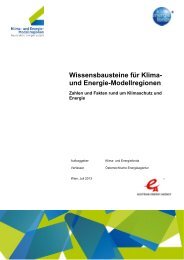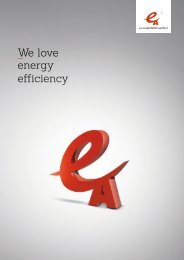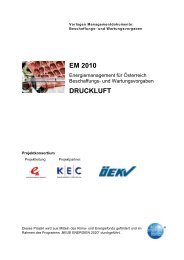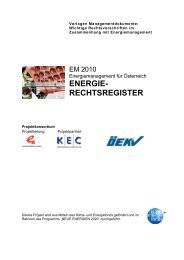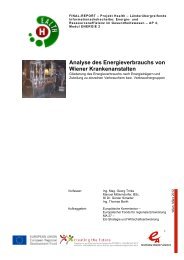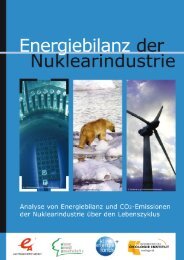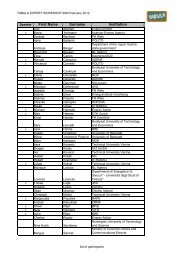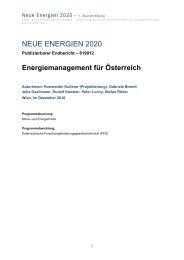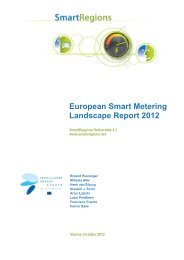Contact
Contact
Contact
You also want an ePaper? Increase the reach of your titles
YUMPU automatically turns print PDFs into web optimized ePapers that Google loves.
<strong>Contact</strong><br />
Organisation:<br />
Austrian Energy Agency<br />
Address: Mariahilfer Strasse 136, 1150 Vienna<br />
Phone: +43 (0) 1 586 15 24 Fax: +43 (0) 1 586 15 24‐340<br />
<strong>Contact</strong>: tabula‐event@energyagency.at<br />
Project management:<br />
Maria Amtmann – Austrian Energy Agency<br />
maria.amtmann@energyagency.at<br />
International project website:<br />
www.building‐typologie.eu/event<br />
All the presentations, information and pictures will be available online:<br />
http://tabula‐event.energyagency.at<br />
Friendly supported by
Programme<br />
09:00 Welcome<br />
09:10 Block I: The European Housing Stock – Overview and Typological Assessment<br />
09:10 Oliver Rapf – Buildings Performance Institute Europe (BPIE) – Belgium<br />
”European Buildings under the Microscope“<br />
09:45 Tobias Loga – Institute for Housing and Environment (IWU) – Germany<br />
”National building typologies: basis for energy consultancy and building<br />
stock models – the TABULA project“<br />
10:25 Coffee break<br />
10:55 Block II: TABULA Building Typologies in the Respective National Context –<br />
Concepts and Application Fields<br />
10:55 Elena Dascalaki – National Observatory of Athens (NOA) – Greece<br />
”Building typologies as a tool for energy consultancy and housing stock<br />
assessment – A case study for the Hellenic residential building stock“<br />
11:15 Short presentations from Poland, Ireland, Slovenia, Italy, Czech Republic<br />
National Building Typologies development in the framework of the TABULA<br />
project – presentations by:<br />
Malgorzata Popiołek – National Energy Conservation Agency (NAPE) – Poland<br />
Michael Hanratty – Energy Action – Ireland<br />
Marjana Sijanec Zavrl – Building and Civil Engineering Institute (ZRMK) –<br />
Slovenia<br />
Vincenzo Corrado – Politecnico di Torino (POLITO) / Department of Energetics<br />
Tomáš Vimmr – STU‐K – Czech Republic<br />
12:05 Nele Renders – Flemish Institute of Technological Research (VITO) – Belgium<br />
”Realistic saving potentials? The correlation of calculated and actual<br />
measured energy use“<br />
12:20 Questions / discussion<br />
12:30 Lunch break<br />
13:30 Block III: Methodical Challenges – Information about National Housing<br />
Stocks – EPC Database Analyses – Surveys<br />
13:30 Manuel Casquiço – Agência para a Energia (ADENE) – Portugal<br />
”Statistical information from the Portuguese EPC database “
13:50 Maria Amtmann – Austrian Energy Agency (AEA) – Austria<br />
”Definition of average buildings – Statistical information from the Austrian<br />
EPC database – Use for the building stock model Austria“<br />
14:10 Kim B. Wittchen – Danish Building Research Institute (SBi) – Denmark<br />
”Statistical information from the Danish EPC database ‐ Use for the building<br />
stock model Denmark“<br />
14:30 Nikolaus Diefenbach – Institute for Housing and Environment (IWU) –<br />
Germany<br />
”Data collection in the framework of a house owner survey – Input for the<br />
building stock model Germany“<br />
14:50 Questions / discussion<br />
15:00 Coffee break<br />
15:30 Block IV: Modelling Refurbishment Processes / Scenario Calculations<br />
15:30 Gordon Sutherland – Executive Agency for Competitiveness & Innovation<br />
(EACI) – European Commission<br />
”EU Climate Protection Targets in the Building Sector – Policies and<br />
Measures“<br />
15:55 John Riley – Building Research Establishment (BRE) – United Kingdom<br />
”Characterisation of dwellings in the UK – determining the potential for<br />
enhanced energy efficiency“<br />
16:20 Niko Heeren – ETH Zürich / Institut für Bau‐ und Infrastrukturmanagement –<br />
Switzerland<br />
”Component‐based building stock model for testing the targets of the Swiss<br />
2000 Watt society“<br />
16:45 Lukas Kranzl – Technische Universität Wien – Austria<br />
”Modelling the impact of energy policies in the building sector“<br />
17:10 Questions / discussion<br />
17:20 Tobias Loga – Institute for Housing and Environment (IWU) – Germany<br />
Closing words: Monitoring of national housing stocks: current state,<br />
challenges, perspectives<br />
17:30 Dinner
Workshop Guide<br />
09:00 Welcome<br />
09:10 Block I: The European Housing Stock – Overview and Typological Assessment<br />
09:10 Oliver Rapf – Buildings Performance Institute Europe (BPIE) – Belgium<br />
”European Buildings under the Microscope“<br />
Buildings present one of the highest energy saving potentials. Improving energy efficiency of<br />
buildings can substantially contribute to Europe’s 2020 strategy and 2050 roadmap targets. The<br />
transformation of the existing building stock is a complex process requiring an understanding on the<br />
current status of the building stock. Based on an extensive survey carried out across the EU, BPIE<br />
shows that significant efforts are required to close current data gaps and harmonize monitoring,<br />
reporting and evaluation. The data collected is used in a model which develops renovation scenarios<br />
assuming different renovation depth and speed pathways and achieve the same overall target: to<br />
renovate all the existing stock by 2050.<br />
Oliver Rapf is the Executive Director of The Buildings Performance Institute Europe<br />
(BPIE).<br />
Before joining BPIE, Oliver Rapf was Head of the Climate Business Engagement<br />
unit of WWF International, managing strategy and partnership development with<br />
the private sector. Leading an international team, he advised multinational<br />
companies on climate change.<br />
Oliver’s experience in buildings efficiency goes back to the late 1990s when he was<br />
a project leader for several deep renovation projects on behalf of WWF in<br />
cooperation with housing companies across Germany. Other roles include the<br />
position of deputy Head of WWF’s European Climate Change and Energy Policy<br />
Unit. Oliver participated in UNFCCC negotiations and was the leader of the<br />
German NGO coalition at international climate change negotiations.<br />
09:45 Tobias Loga – Institute for Housing and Environment (IWU) – Germany<br />
”National building typologies: basis for energy consultancy and building stock<br />
models – the TABULA project“<br />
A national building typology on the basis of the TABULA concept provides a basis for energy<br />
consultancy and for building stock models. It is created by classifying the building portfolio according<br />
to certain energy‐related parameters and assigning an example building to each building type. A<br />
further step is the creation of "average buildings" as representatives, on condition that the necessary<br />
statistical information is available. A common reference calculation procedure facilitates the cross‐<br />
border exchange of information about the energy performance of typical buildings and particular<br />
refurbishment strategies.<br />
10:25 Coffee break<br />
1989 to 1991 energy consultancy in an architectural office; since 1992 scientist at<br />
IWU – Institut Wohnen und Umwelt GmbH (Institute for Housing and<br />
Environment), Darmstadt, Germany. The fields of expertise of Tobias Loga are:<br />
design of energy efficient buildings, development of tools for calculating energy<br />
balances and for energy advice, concepts and implementation of energy<br />
performance certificates, simplifications for energy performance calculations,<br />
building typologies.
10:55 Block II: TABULA Building Typologies in the respective National Context – Concepts<br />
and Application Fields<br />
10:55 Elena Dascalaki – National Observatory of Athens (NOA) – Greece<br />
”Building typologies as a tool for energy consultancy and housing stock<br />
assessment – A case study for the Hellenic residential building stock“<br />
The TABULA classification of residential buildings in Greece is based on the age and size of the<br />
buildings and the climatic variability in the country. This presentation gives an overview of the<br />
Hellenic building typology and some results from its application as a tool to get an insight of the<br />
national residential building stock assessing typical and advanced energy conservation measures in<br />
an effort to meet the 9% indicative national energy savings target by 2016.<br />
Dr. Elena Dascalaki, Building Physicist, Senior Researcher at NOA/IERSD since 2006<br />
and research assistant with GREC since 2001. Active in the areas of building physics<br />
– thermal performance of buildings and energy conservation, thermal building<br />
simulations, CFD building applications, numerical analysis, natural ventilation,<br />
building energy audits. Leading researcher in various European and National<br />
Research Programmes. National representative in the Annex 35 technical<br />
committee of the International Energy Agency working on Hybrid Ventilation.<br />
Author and co‐author of 33 papers in international and national journals, 6 books<br />
and chapter contributions in scientific books on energy conservation and RES,<br />
56 papers for conferences, 10 scientific publications and 26 technical reports.<br />
Professional Activities: Member of the Board of Directors of the Centre for<br />
Renewable Energy Sources – CRES (2010‐today), Hellenic Physics Association.<br />
11:15 Short presentations from Poland, Ireland, Slovenia, Italy, Czech Republic<br />
National Building Typologies development in the framework of the TABULA project<br />
– presentations by:<br />
Malgorzata Popiołek – National Energy Conservation Agency (NAPE) – Poland<br />
Polish building typology will be presented, including final building matrix, approved construction<br />
periods and building types. The sources of data, accepted modernisation measures, as well as final<br />
brochure will be also a subject of the lecture.<br />
From 1999 Project Manager in National Energy Conservation Agency. Member of<br />
the Board of the Energy Conservation Foundation. Expert in the field of renewable<br />
energy and energy efficiency in buildings. Lecturer for courses for energy auditors<br />
and energy experts as well as for post‐graduate studies at the Warsaw University of<br />
Technology. Certified Energy Manager issued by American Engineering Association.<br />
Coordinator of several European projects such as DEMOHOUSE, Green City<br />
Building, DATAMINE, BEST RESULT and PROMOTION3e. Author of articles in<br />
professional magazines (“Energy and buildings”, “ How to save energy”, “Eko‐<br />
partner”) and co‐author of a handbook for energy auditors.
11:25 Michael Hanratty – Energy Action – Ireland<br />
Ireland’s National Energy Efficiency Action Plan (NEEAP) 2009–2020 set a challenging target of<br />
delivering 20% energy savings by 2020 across all sectors. It is estimated that 1 million building<br />
upgrades are required across the residential, commercial and public sectors. Significant retrofit<br />
programmes are underway in Ireland on the residential housing stock in particular. The Irish<br />
conference presentation will indicate how the TABULA project is relevant to and is contributing to<br />
existing and future retrofit programmes in Ireland.<br />
He has been engaged by Energy Action as an in‐house consultant since 2003<br />
working on the IEE projects Datamine (2005–2008) and TABULA (2009–2012).<br />
He is also Managing Director of IHER Energy Services, a building energy<br />
consultancy company formed in 2007 in partnership with Energy Action.<br />
IHER focuses on energy‐related training, energy surveying and research work.<br />
Michael is an electrical engineer and previously worked for the main electrical<br />
utility in Ireland for 20 years up to 2002, laterally in the energy efficiency field.<br />
11:35 Marjana Sijanec Zavrl – Building and Civil Engineering Institute (ZRMK) – Slovenia<br />
Early attempts to assemble Slovenian building typology have been made in the past with only two<br />
size types (single family houses and apartment building) and without the contribution of building<br />
systems. TABULA approach brought a new concept to the building typology. By defining typology<br />
subtypes it was possible to describe buildings not only in their original state but also in present<br />
modernized state, thus enabling us to model national energy balance and saving scenarios. Based on<br />
this typology, a new TABULA‐based software for quick energy saving calculations for residential<br />
buildings was developed.<br />
Marjana Sijanec Zavrl, Head of Centre for Indoor Environment, Building<br />
Physics and Energy. She has 27 years of professional experience in building<br />
physics, energy efficiency in buildings, sustainable and energy efficiency<br />
renovation of existing buildings. She drafted EPBD‐based technical regulation<br />
on energy efficiency in buildings, mainly calculation methodology, minimum<br />
requirements and energy certification and labelling of buildings. Special focus<br />
of her interest is also monitoring of microclimate in heritage buildings,<br />
preventive restoration measures for heritage, environmental assessment of<br />
buildings, LCA, LCC in buildings and sustainable building. Since 1997 she has<br />
also been employed as a researcher at University in Ljubljana, Faculty for Civil Engineering and Geodesy.<br />
Recently, she has been involved in many EU projects from EIE, FP6, FP7, Eureka and COST programmes.<br />
11:45 Vincenzo Corrado – Politecnico di Torino (POLITO) / Department of Energetics<br />
The lecture presents the Italian building typology and the criteria of definition of representative<br />
building types according to TABULA common methodology. Both statistical analysis and experience<br />
have been used to develop the Building Typology Matrix. Typical constructions and systems are<br />
presented considering different construction ages. Standard and advanced refurbishment measures<br />
applied to the different building types have been assessed through energy performance calculation<br />
carried out according to European and national technical standards. The energy saving potential of<br />
the residential building stock is presented, determined with the support of statistical data.
Civil engineer, associate professor of “Building Physics and Building Services”<br />
at Politecnico di Torino. Author of more than 160 publications. Researcher<br />
and consultant in the fields of energy efficiency, building physics and<br />
environmental comfort. President of IBPSA‐Italy, Italian regional affiliate of<br />
IBPSA (International Building Performance Simulation Association) and<br />
member of the Board of IBPSA‐World. President of the Foundation of the<br />
Order of engineers of the province of Torino. Coordinator of WG 102 (Thermal<br />
insulation of buildings – Calculation and test methods) of the Italian Thermo‐<br />
technical Committee and Italian delegate of CEN TC89. Member of the<br />
working group of the Ministry of Productive Activities for the implementation of EPBD. Italian member of the<br />
following European R&D projects: SEMANCO, TABULA, DATAMINE. Responsible for many national and regional<br />
R&D projects on energy and environmental performance of buildings.<br />
11:55 Tomáš Vimmr – STU‐K – Czech Republic<br />
There has not been any specific approach recognized recently at the national level that could be used<br />
to evaluate the energy performance of large groups of buildings. Czech national building typology has<br />
been developed in the framework of TABULA project. Relevant datasets were included in TABULA<br />
tool offering multiple scenarios and facilitating the strategic asset management. This lecture gives an<br />
overview of typical features of the Czech housing stock and shows examples of applications of<br />
TABULA methodology in the Czech national context.<br />
Tomáš Vimmr, 1990–1991 Post‐graduate courses in design of reinforced concrete<br />
and prestressed concrete structures, Centre des Hautes Etudes de la Construction<br />
(CHEC), Paris; 1980– 1984 Building engineer, CVUT – Czech Technical University of<br />
Prague; Member of the board of directors and technical director of private<br />
consulting firm STU‐K. Senior consultant. Active participant in several IEE projects<br />
(SUREURO, ESAM, SUREFIT, ENPIRE, TABULA, AFTER) and ICT PSP<br />
Competitiveness and Innovation European project (BECA). Involved in several<br />
refurbishment projects of large panel buildings in the Czech housing sector and in<br />
urban restructuring projects. Experienced in technical assessments, site<br />
supervisions and technical inspections on building sites. Recently specialised in<br />
energy performance‐related issues with special focus on housing maintenance<br />
and renovation projects. Active participation in several national conferences on<br />
sustainable housing renovations and energy efficiency in the residential sector.<br />
12:05 Nele Renders – Flemish Institute of Technological Research (VITO) – Belgium<br />
”Realistic saving potentials? The correlation of calculated and actual measured<br />
energy use“<br />
The correlation of calculated and actual measured energy use: evaluation of an energy advice and<br />
consequences for building stock assessment. The theoretical energy consumption tends to be much<br />
higher than the actual energy use due to occupant behaviour, especially for older buildings. In order<br />
to present realistic energy savings, we add a correction factor to the theoretical energy estimations.<br />
These correction factors are derived from statistical analysis of the Energy Advice Procedure<br />
databases of Belgian dwellings. We applied the factors in our two approaches to model the energy<br />
use of dwellings, namely in the typical and the representative housing approach.
12:20 Questions / discussion<br />
12:30 Lunch break<br />
Nele Renders graduated in 2005 as Bio‐Engineer in the Environmental Technologies at<br />
the Katholieke Universiteit Leuven. That year, she started working at VITO or the<br />
Flemish Institute of Technological Research. She is involved in the estimation of the<br />
energy and emission projections for different regional levels: federal, regional or city<br />
level. In this context, she is responsible for the residential and service sector. Within<br />
this scope, she developed the Flemish Environmental Costing Model for the building<br />
sector. Moreover, in the European study “Assessment and improvement of<br />
methodologies used for greenhouse gas projections“ she set up tiered guidelines for<br />
the building sector. In addition to modeling, she evaluated the REU‐reports (Rational<br />
Energy Use) of the Flemish administrators of the distribution network.<br />
13:30 Block III: Methodical Challenges – Information about National Housing Stocks – EPC<br />
Database Analyses – Surveys<br />
13:30 Manuel Casquiço – Agência para a Energia (ADENE) – Portugal<br />
”Statistical information from the Portuguese EPC database“<br />
“Portuguese Certification System for Energy an Indoor Air Quality – Overview, Database Analysis and<br />
Management”<br />
Since 1 st of July 2007 more than 470 thousand energy performance certificates have been issued<br />
under the Portuguese Certification System for Energy and Indoor Air Quality. All these EPC have to be<br />
issued on a specific web platform developed for this purpose based on specific rules to assure the<br />
quality of the data. The information contained in all EPC can be extracted in order to analyze the<br />
Portuguese building stock, his thermal behavior and the recommendations proposed by the experts<br />
to improve it.<br />
Degree in Civil Engineering in 2001 and a specialization in management and business<br />
strategy in 2006. Since 2001 projects and construction management for several<br />
construction companies. 2007 he joined ADENE Building Department as an Auditor<br />
checking the quality of the EPC issued by the qualified experts under the National<br />
Certification System for Energy an Indoor Air Quality. Representative of ADENE in the<br />
European project REQUEST and in the EnR Buildings Working Group.<br />
13:50 Maria Amtmann – Austrian Energy Agency (AEA) – Austria<br />
”Definition of average buildings – Statistical information from the Austrian EPC<br />
database ‐ Use for the building stock model Austria“<br />
The development of a building typology could be accomplished by combination of available data<br />
information out of an EPC database, literature sources and national statistics. Average values taken<br />
out of literature were used to select one typical building for each typology out of the EPC database.<br />
As "representative" apply buildings which in terms of their U‐value, gross floor area, space heating<br />
and domestic hot water systems represent average buildings. Thus, the 28 national model buildings<br />
for the national brochure and the 140 model buildings for the webtool are finally represented by<br />
real, existing “average” buildings.
Studies of Architecture and urbanism at the University of Technology in Graz,<br />
Architecture School la Villette in Paris and Central University of Venezuela. Degree in<br />
2007 and specialization in energy efficient building solutions in 2010. Since 2007<br />
realization of architecture projects, researcher at the Austrian Energy Agency since<br />
2010. Active in the fields of energy savings in buildings, assessment of building stocks,<br />
low‐energy buildings, solar architecture, use of renewable energy systems in urban<br />
environments. National project management of the European project TABULA and the<br />
international project IEA SHC Task 41, Solar Energy and Architecture.<br />
14:10 Kim B. Wittchen – Danish Building Research Institute (SBi) – Denmark<br />
”Statistical information from the Danish EPC database ‐ Use for the building stock<br />
model Denmark“<br />
Information from the Danish Energy Performance (EP) Certificate data has been used in the<br />
development of average building stock models in Denmark. There has been mandatory EP<br />
certification in Denmark since 1997 for small residential houses, and data on the physical end<br />
geometrical stage of the buildings have been collected in central databases. This information has,<br />
together with information from the building stock register database, been analysed and used for<br />
creation of average building typologies. Nine typical construction periods have been identified, based<br />
on changes in building tradition and for the recent periods, changes in energy requirements.<br />
Analyses of energy saving potentials in the existing building stock, based on data<br />
extracted from the Danish Energy Performance Certification (EPC) scheme. The<br />
analyses were made for the Danish Energy Agency and have been used in the<br />
development of the government’s strategy for achieving a CO2 emission‐free society by<br />
2050. Member of the management team for EU EPBD Concerted Action (CA) and co‐<br />
core theme leader for “Certification procedures” in CAII and “Energy performance<br />
requirements, using the cost‐optimum methodology” in CAIII. Participant in numerous<br />
international projects, e.g. IEA SHC task 40 / ECBCS Annex 52 “Towards Net Zero Energy<br />
Solar Buildings “; EPA‐ED & EPA‐NR “Energy Performance Assessment of residential and<br />
non‐residential buildings”; REQUEST “REnovation through QUality supply chains and EPC Standards”.<br />
Qualifications: Project management, Low energy buildings, Analyses of energy upgrading potentials for existing<br />
buildings, Energy savings in buildings, Use of renewable energy systems in urban environments, Energy optimal<br />
control strategies, Energy Regulations and Requirements, Demonstration projects, Measurements and<br />
evaluation of building performance, Calculation and simulation of energy consumption and indoor<br />
environment as well as simulation model development.<br />
14:30 Nikolaus Diefenbach – Institute for Housing and Environment (IWU) – Germany<br />
”Data collection in the framework of a house owner survey – Input for the building stock model<br />
Germany“<br />
During the TABULA project a model for analysing the energy consumption and energy saving<br />
potentials of the German residential building sector was developed. A representative survey of house<br />
owners carried out in an earlier project was used as an information source for the current state of<br />
the building stock, inter alia the fraction of old buildings which have already been modernised.<br />
He completed his studies of physics at RWTH Aachen in 1995 and received a PhD in<br />
mechanical engineering at Ruhr‐Universität Bochum in 2002.<br />
Since 2000 he is scientist at the Institut Wohnen und Umwelt (Institute for housing and<br />
environment) in Darmstadt.<br />
He works on energy saving concepts by thermal protection and efficient heat supply<br />
systems and on the evaluation of climate protection politics in the building sector.
14:50 Questions / discussion<br />
15:00 Coffee break<br />
15:30 Block IV: Modelling Refurbishment Processes / Scenario Calculations<br />
15:30 Gordon Sutherland – Executive Agency for Competitiveness & Innovation (EACI) –<br />
European Commission<br />
”EU Climate Protection Targets in the Building Sector – Policies and Measures“<br />
An introduction will be given to the energy and climate targets of Europe 2020, the EU's growth<br />
strategy for this decade. In a changing world, the EU needs to become a smart, sustainable and<br />
inclusive economy. These three mutually reinforcing priorities should help the EU and the Member<br />
States deliver high levels of employment, productivity and social cohesion. The climate/energy<br />
targets are an integral part of that policy. Concrete actions and EU legislation at EU level underpin<br />
the strategy and these will be presented.<br />
Since 2010, Senior Project Officer of the Energy‐efficiency Unit of the European<br />
Commission's Executive Agency for Competitiveness and Innovation (EACI), which<br />
implements the EU's IEE Programme; 2006–2010, formerly Project Officer in the field<br />
of Energy‐efficient Buildings in the same unit; 2002–2005, Supervising Mechanical<br />
Engineer for the Olympic Village (Overlays) and Operations Site Manager of the Dekelia<br />
Training Complex, Organising Committee of the Athens 2004 Olympic Games. 1989–<br />
2001, variously at the Centre for Renewable Energy Sources (Passive Solar and Hybrid<br />
Systems Programme), the University of Athens (Group Building Environmental<br />
Studies), Trane Hellas Air‐Conditioning and Lennox Hellas Heating‐Cooling, in Greece,<br />
and Torpy and Partners – Consulting Engineers, United Kingdom. M.Sc in Energy<br />
Conservation and the Environment from Cranfield Institute of Technology, United<br />
Kingdom (1988–1989). B. Eng. in Aeronautical Engineering, Glasgow University (1984–1988).<br />
15:55 John Riley – Building Research Establishment (BRE) – United Kingdom<br />
”Characterisation of dwellings in the UK – determining the potential for enhanced<br />
energy efficiency“<br />
The housing stock in England is among the oldest in Europe. Much of this is in poor condition with<br />
low levels of energy efficiency. Characterisation of the English housing stock must consider the<br />
dwelling condition, size, built form and presence of existing measures to allow the assessment of the<br />
potential for improving energy efficiency. The comprehensive data from the English Housing Survey<br />
allows the development of relevant typologies and quantify the likely effects of energy efficiency<br />
improvements.<br />
John joined BRE in 1998 to lead the energy efficiency modelling work for housing. He now<br />
manages the Housing Stock Performance Group where he is responsible for energy<br />
modelling, energy statistics, housing stock modelling and social research. John has over<br />
20 years of experience in energy modelling for the UK domestic housing stock. He is<br />
currently the BRE Project Manager for several contracts in the area of housing energy<br />
efficiency and fuel poverty undertaken on behalf of the Department of Energy and<br />
Climate Change (DECC) and other organisations.
16:20 Niko Heeren – ETH Zürich / Institut für Bau‐ und Infrastrukturmanagement –<br />
Switzerland:<br />
”Component‐based building stock model for testing the targets of the Swiss 2000<br />
Watt society“<br />
The building stock model of ETH Zurich and TEP Energy GmbH analyses the environmental impact of<br />
building stocks. It is a component‐based bottom‐up model including the energy supply side of<br />
buildings. It uses statistical data on surface distribution and retrofit activity of building envelopes.<br />
Buildings with similar characteristics are clustered into cohorts. Model outputs are greenhouse gas<br />
emissions and primary energy demand until 2050. So far, case studies for Switzerland and the city of<br />
Zurich have been realized.<br />
He studied “Environmental & Resource Management” and “ClimaDesign”.<br />
Since 2008 he is working at the Chair of Sustainable Construction at the ETH Zurich<br />
Switzerland.<br />
His work focuses on environmental assessment of construction material and building<br />
stocks. In the past he developed different bottom‐up models for several building stocks.<br />
16:45 Lukas Kranzl ‐ Technische Universität Wien ‐ Austria<br />
”Modelling the impact of energy policies in the building sector“<br />
This presentation will discuss an approach for modeling energy policies in the building sector. This<br />
will include: (1) structure and basic algorithms of the model Invert/EE‐Lab (Ernstl/EE‐Lab),<br />
(2) disaggregated description of the building stock: level of disaggregation, types of buildings<br />
distinguished, types of parameters, (4) selected scenarios and results (discussing the role of the<br />
rebound effect), (5) open questions, next steps, in particular in the IEE‐project ENTRANZE (Policies to<br />
enforce the transition to nearly zero energy buildings in the EU‐27).<br />
17:10 Questions / discussion<br />
He currently is working as a senior researcher at the Energy Economics Group. He<br />
joined the Institute of Energy Economics in 1999. He holds a degree in industrial<br />
economics and mechanical engineering and a Ph.D in energy economics at Vienna<br />
University of Technology. His research activities are sustainable energy systems with a<br />
focus on buildings, bioenergy, scenario development and optimisation of policy<br />
instruments for renewable and efficient energy systems. In these areas Lukas Kranzl is<br />
responsible for project acquisition, scientific coordination and research activities.<br />
17:20 Tobias Loga – Institute for Housing and Environment (IWU) – Germany<br />
Closing words: Monitoring of national housing stocks: current state, challenges,<br />
perspectives<br />
17:30 Common Dinner – Minoriten Front Hall
notes
notes
notes



